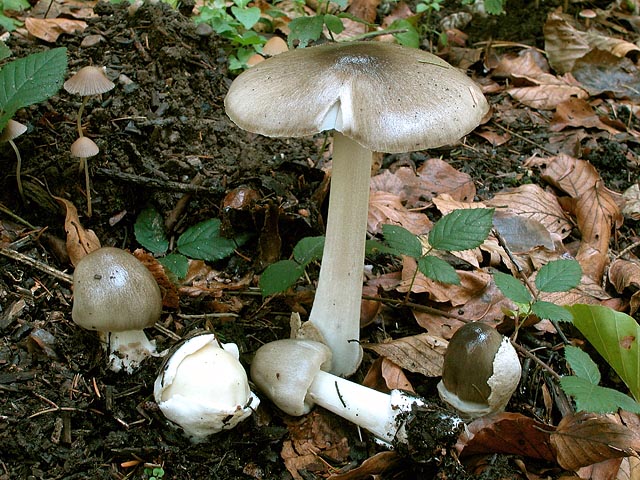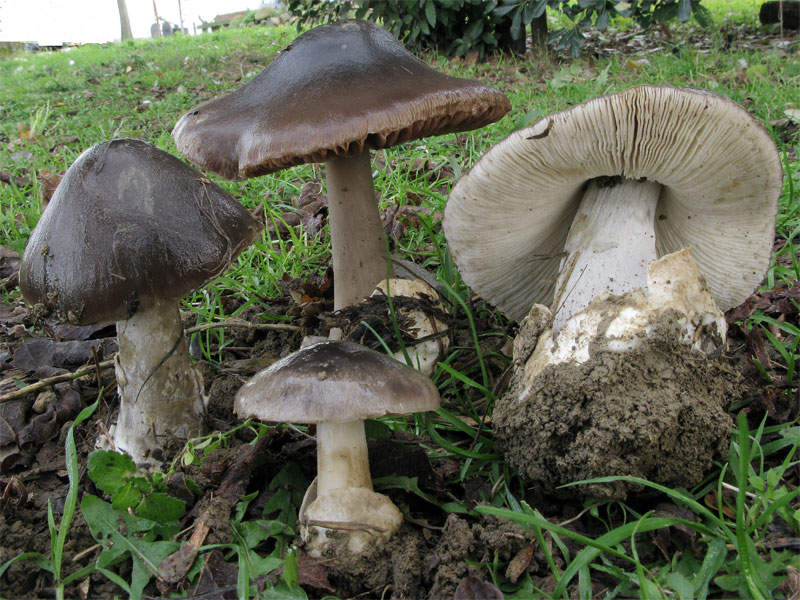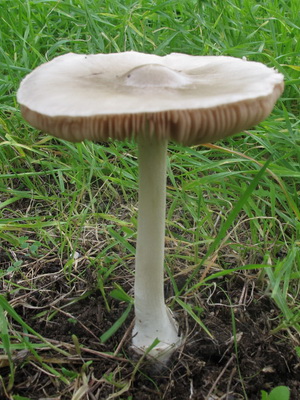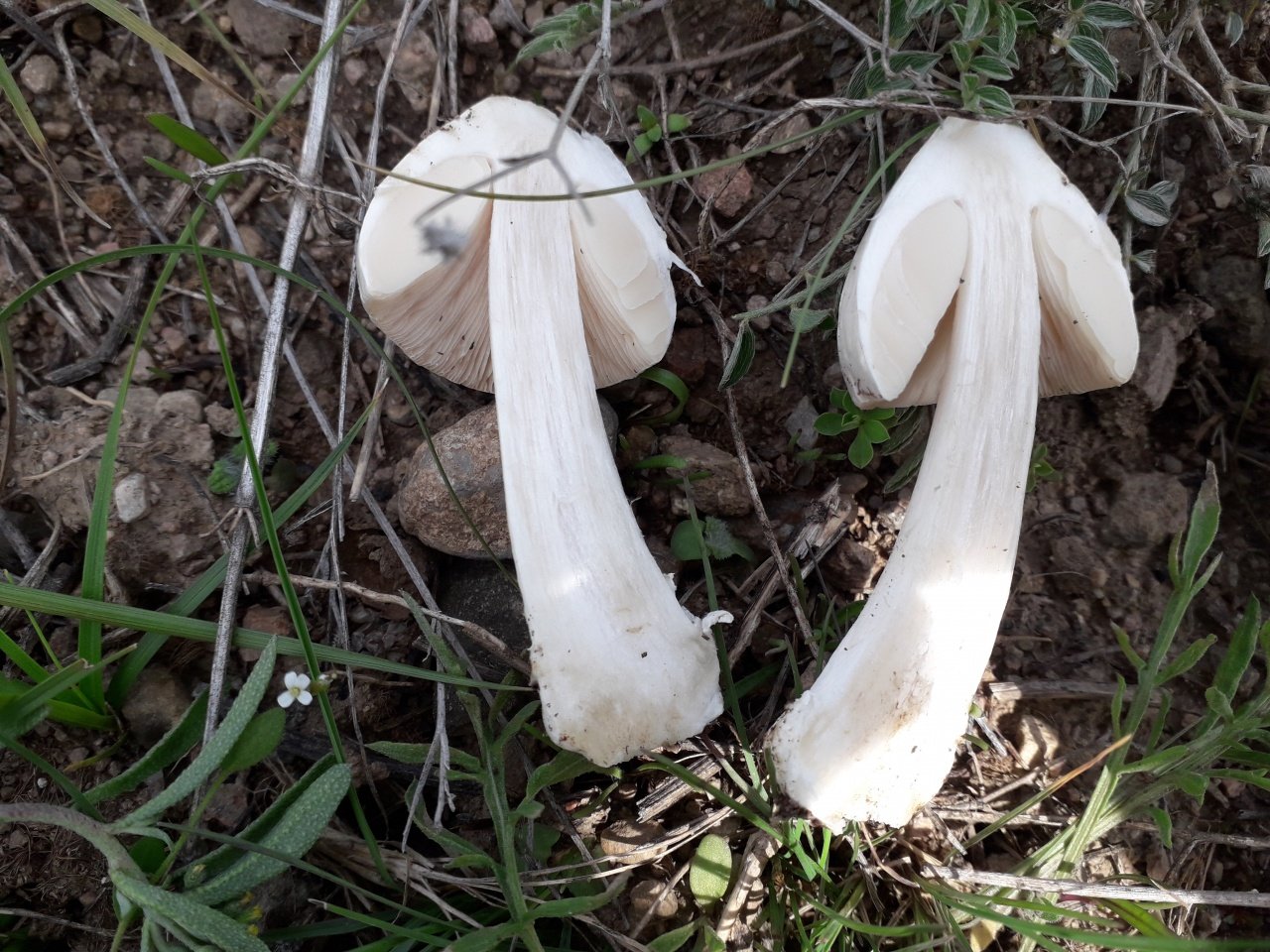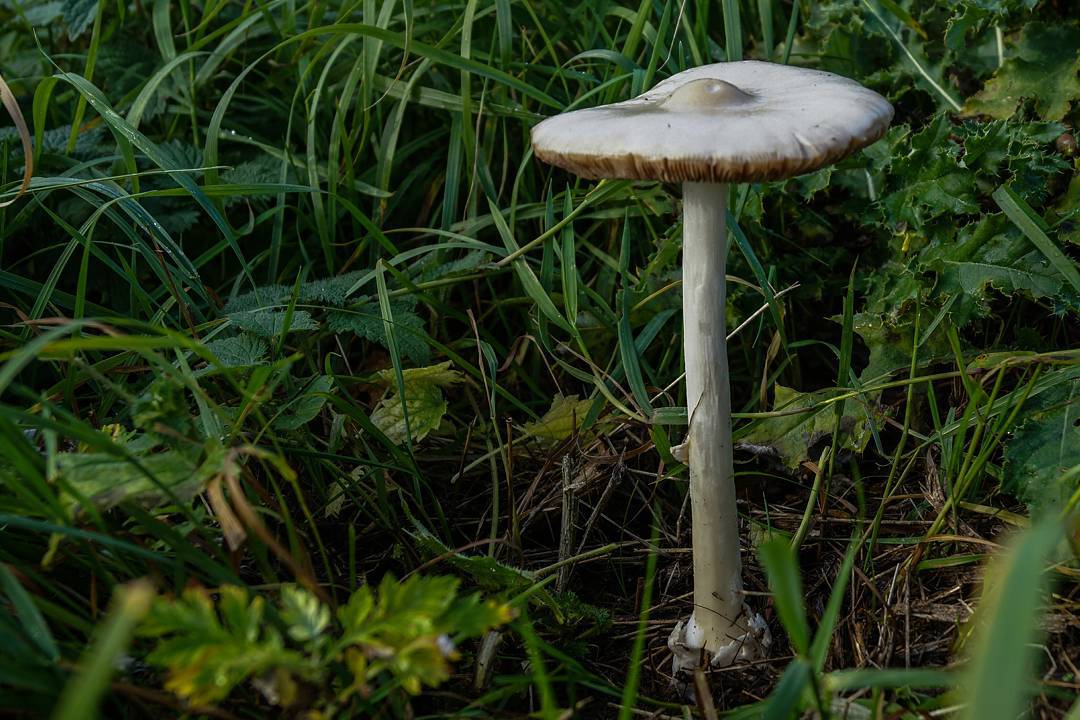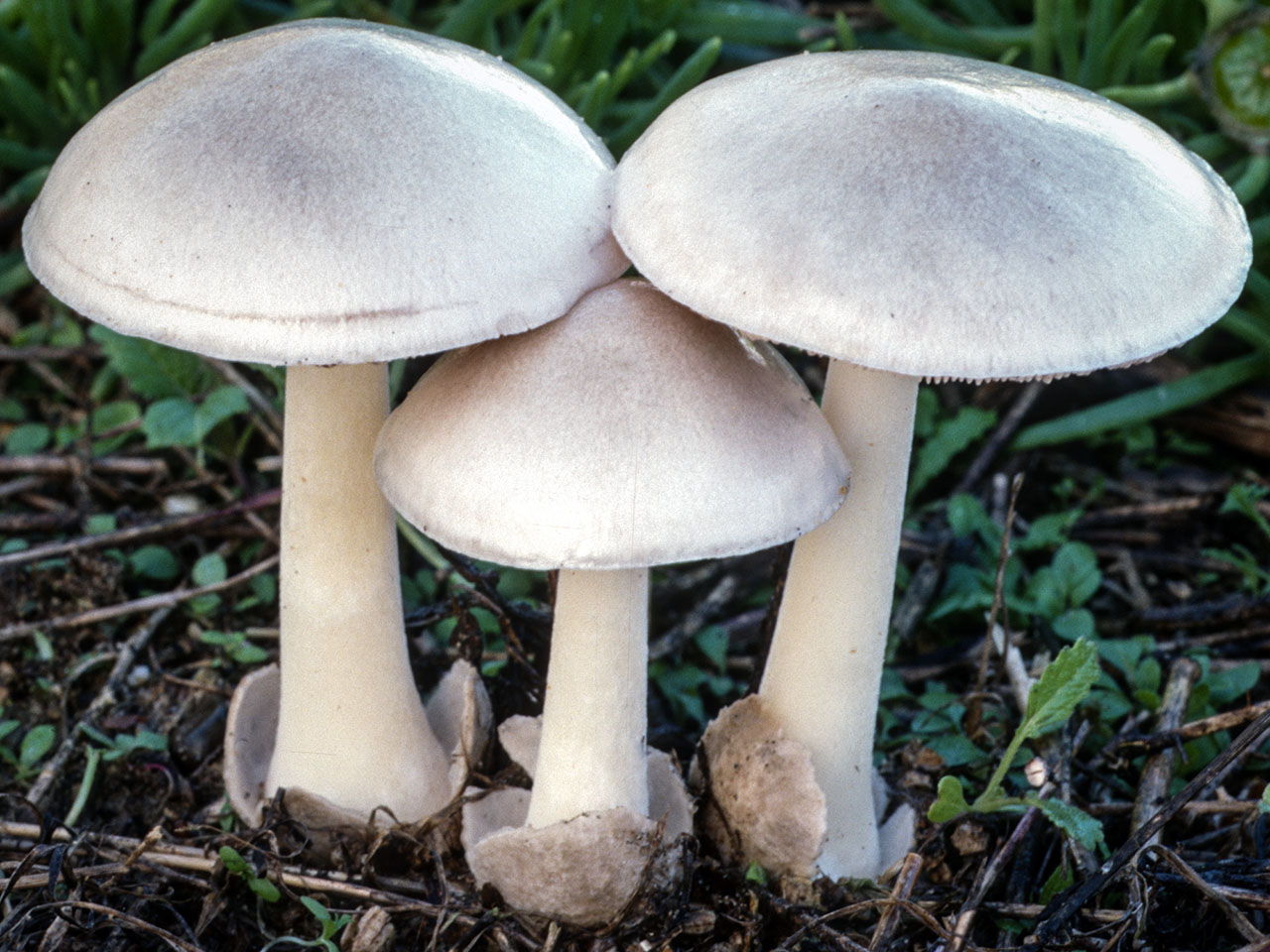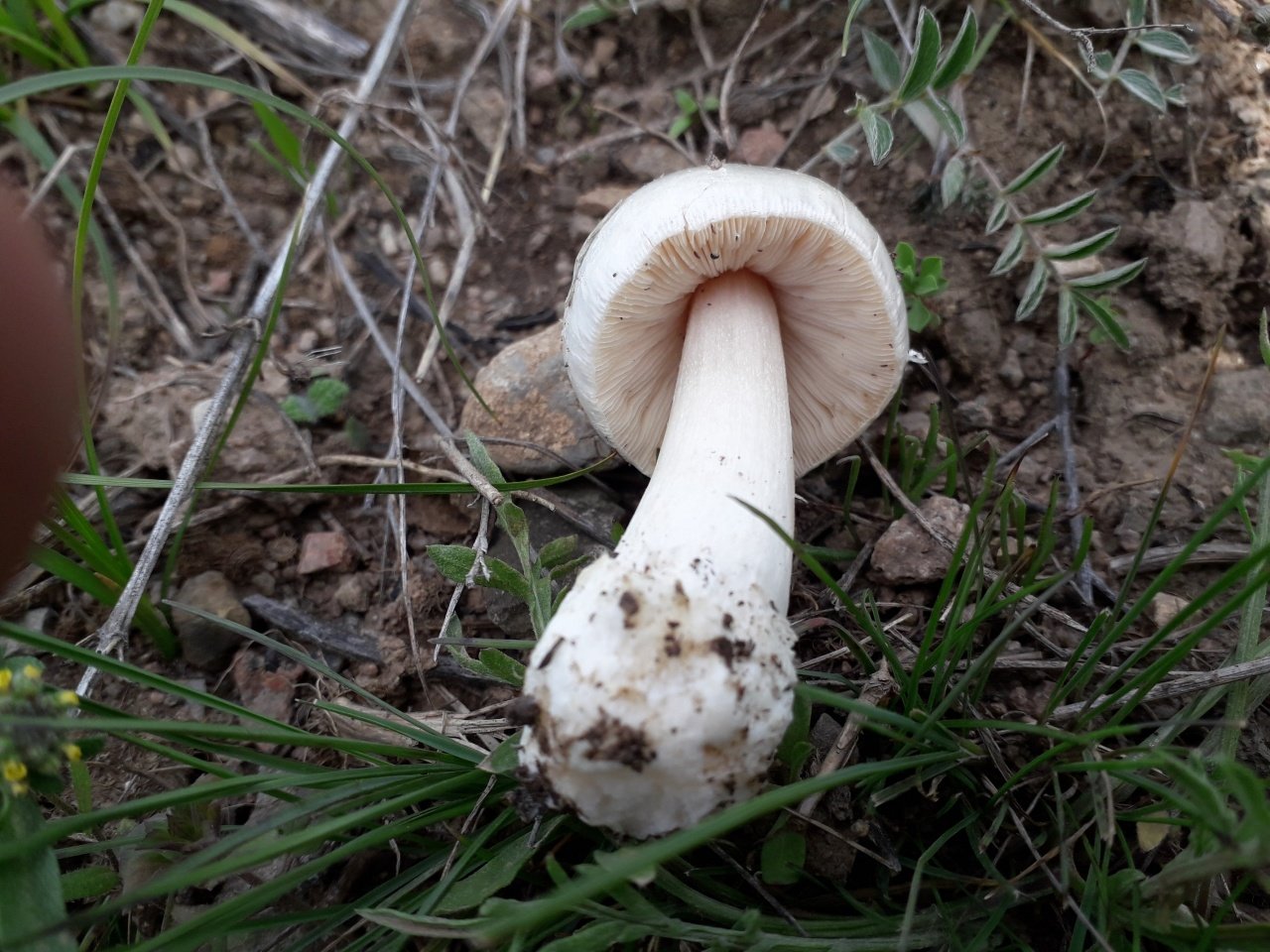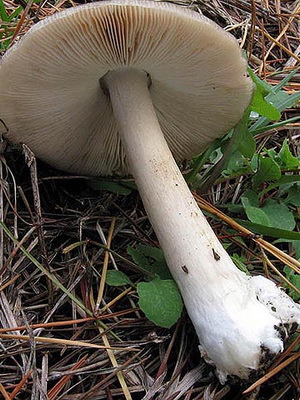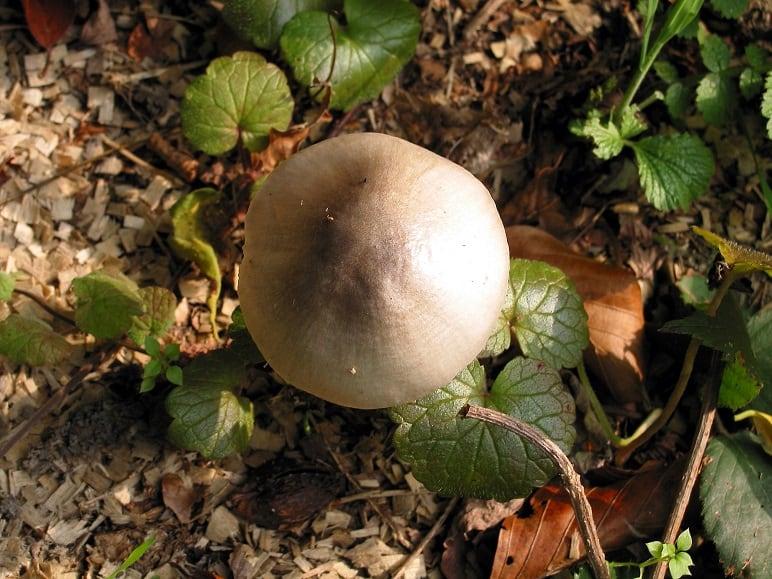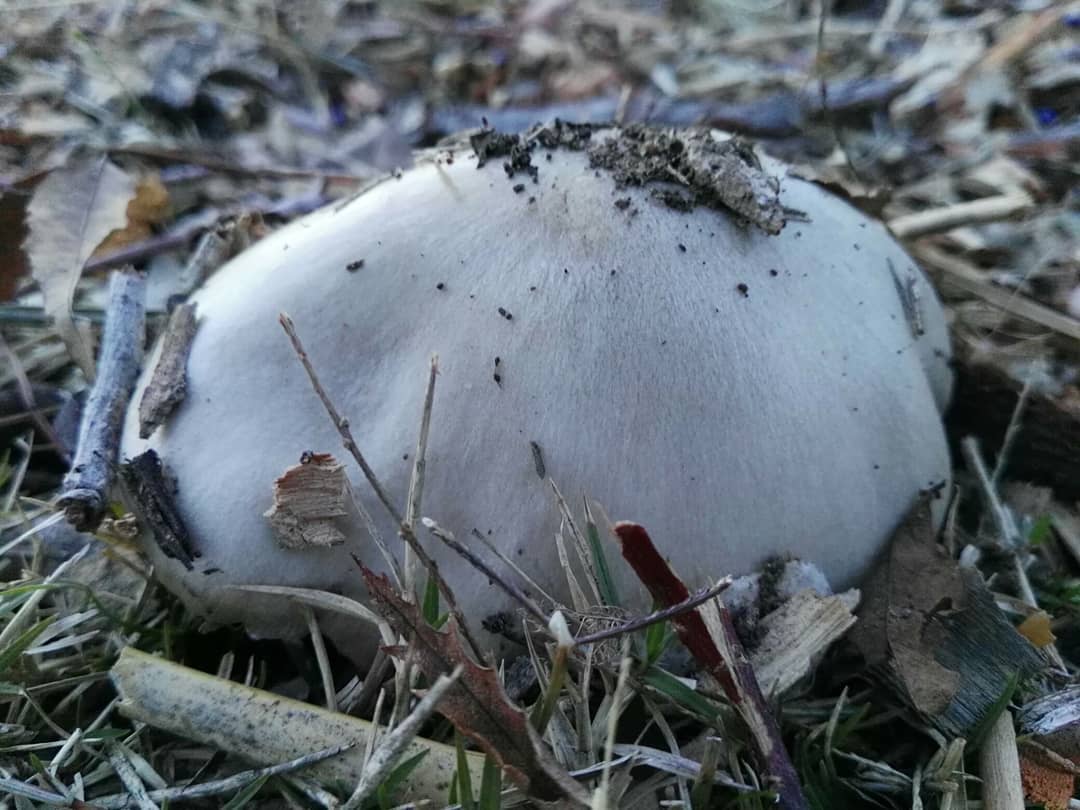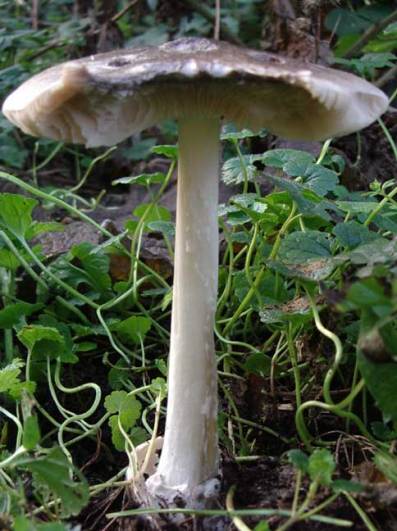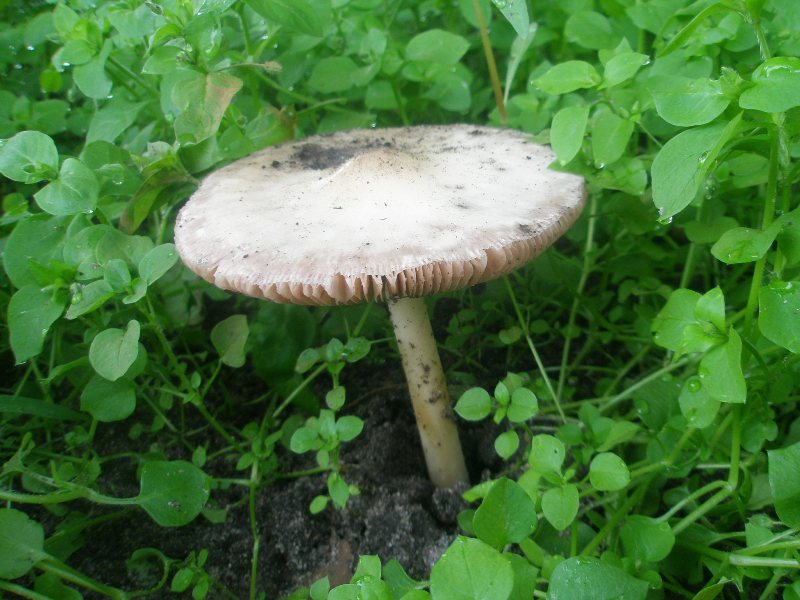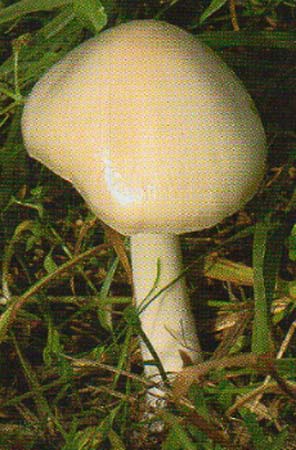Views
The Volvariella mushroom has the following species.
Volvariella viscous hat
It is considered the largest type of volvariel.
The surface of the mushroom cap is smooth, a slight stickiness is felt to the touch. Diameter up to 20 cm. The shape of the cap of a young mushroom is similar to an egg. After growing up, it becomes like a bell with a lowered edge, later the shape becomes flat with a pronounced tubercle in the center of the cap. The color is from white to gray, the color of the plates is from white to light pink. The leg is thin and long, up to 25 cm, the color is white or yellow at the base, it may have a gray tint. The leg of a young mushroom is pubescent, in an adult it is smooth.
The peculiarity of this species is not too pronounced, but fresh smell and taste, reminiscent of a cucumber or radish. Volvariella viscous hat quickly loses its taste, so it is necessary to cook it as quickly as possible after harvesting, without leaving it for a long time, otherwise the dish will become tasteless. The mushroom is considered edible or conditionally edible, that is, it requires preliminary boiling. Most often they are salted or pickled.
This species grows in the middle lane, in the temperate zone. Inhabits humus-rich soils, compost heaps. It practically does not occur in forests. Grows mostly singly, rarely in groups.
Volvariella is beautiful
Grows on living or dead deciduous trees. The size of the cap is from 5 to 15 cm, sometimes it can grow up to 20 cm. In young mushrooms, the shape of the cap is ovoid, when ripe, the cap opens, its edge becomes serrated. Color from white to straw yellow. The plates of a young mushroom are white; when the spores mature, they turn pink. The stem is smooth, long, 1 to 2 cm in diameter, evenly widens towards the base.
The flesh of the mushroom is firm but soft. Has a fresh taste, but practically odorless.
In Russia, they practically do not know about this mushroom, but in some Asian countries it is considered an exquisite delicacy.
Volvariella is beautiful, aka Volvariella is beautiful
Another species, volvariella is wonderful, edible. It grows on manured soil, compost heaps, in humus. It can often be found in orchards, parks, and vegetable gardens. Occurs from June to September.
The cap is white, in a young mushroom it looks like a bell, subsequently opens, becomes twisted. Color from white or yellowish at the edges to brownish in the center. Leg up to 22 cm in length in an adult mushroom.
Volvariella silky or bombicina
Named silky because of its thin, beautiful color volva
This species is found in mixed forests and parks, attracts attention with a beautiful appearance, but is rare. In some regions of Russia, for example, in Khakassia, Novosibirsk and Chelyabinsk regions, the species is listed in the Red Book and protected by the state
This species is found in countries with a temperate and hot climate. You can find it both in central Russia and in North America, China, Australia.
The caps of this type of volvariella are from 5 to 20 cm in diameter. The shape of young mushrooms is bell-shaped, when ripe it opens, at first it becomes flat, with a pronounced obtuse tubercle in the center, then it becomes convex. The color is from light brown to mouse gray, and can be light straw. The plates of the young mushroom are light pink, after ripening they change their color to bright pink.
The pulp is white or yellowish, dense, has a light and pleasant mushroom smell. Silky volvariella grows actively from mid-June to late August
Cut these mushrooms very carefully so as not to damage the mycelium. Mushrooms cannot be twisted, as the cap crumbles heavily
This species is found in countries with a temperate and hot climate. You can find it both in central Russia and in North America, China, Australia. Experienced mushroom pickers know this species well.
Silky volvariella - from birth to sunset
? svetkuban (svetkuban
) wrote, 2014-09-11 15:34:00svetkuban 2014-09-11 15:34:00
Isn't it a hat from Ms. Brylsky from The Irony of Fate?
Once in a nearby forest, a 15-minute walk from my house, I accidentally stumbled upon this amazing mushroom.
I knew about its existence from mushroom reference books, but I never saw it alive. And here, on a huge old completely dry poplar, not just one Volvariella grew, but a whole family of these mushrooms. Someone is at the foot of the tree giant. Others hid in a deep crevice between huge branches.
Still others climbed high up.
The same poplar
These mushrooms appeared on the tree in autumn from September. And, replacing each other, they grew here until November. I managed to trace their development path from birth to death.
A newborn volvariella silky is enclosed in an egg or volva (from which it got its name).
This mushroom got such a strange name due to the fact that the young mushroom is enclosed in a common shell - volva, which determined the generic name of the mushroom. As the fungus grows, the volva breaks apart and forms a saccular formation at the base of the leg.
The cap is up to 20 cm in diameter, white, first bell-shaped, then open, silky. It is one of the most beautiful lamellar mushrooms growing on wood.
Young Volvariella has recently hatched from her Volvo. There is still a Volvo cap on the top of the head.
And the silk on the hat is just perfect.
In Europe, it is found in the south. Loves warmth.
Volvariella silky has a white flesh, which turns yellow as the mushroom ages, the taste and smell are pleasant.
Volvariella silky grows from July to October on dead trunks of maples, elms, poplars, and can grow in open hollows. Not common.
The silk surface of the cap of a young mushroom is very soft - well, just silk.
Young beauty Volvariella in the juice itself. It's time to collect it. At this age, Volvariella is no longer worth collecting - it is old and pretty much eaten by insects. Old Volvariella begins to dry out.
Another day and this old woman Volvariella will completely droop and fall with her hat on the ground. Her days are numbered; sometimes Volvariella climb a tree very high. And they look with a grin at the unlucky mushroom pickers. It is impossible to get them.
THE STORY IS ENDED
Volvariella mucous head what it looks like, can it be eaten, where it grows, collection rules, photo
Volvariella mucous head: description and photo
The mushroom volvarella mucoushead (magnificent, beautiful) is conditionally edible. It is the largest of the Volvariella genus and can be confused with the toxic fly agaric. Therefore, it is advisable for mushroom pickers to know how this representative looks and where it grows. The official name is Volvariella gloiocephala.
What does volvarella mucous head look like?
Volvariella mucous head at a young age has an egg-shaped cap, enclosed in a volva. As it grows, it takes the shape of a bell, and then becomes convex-outstretched with a tubercle in the very center. In dry weather, the cap is smooth and silky, it contains a diameter of 5 to 15 cm. During rain, the surface becomes sticky and slimy, which is why the fruit was named. The color of the cap is uneven - in the middle it is darker, and at the edges it has a light grayish tint.
The long and thin stem gives the mushroom a graceful look. Its greatest length reaches 20-22 cm, and its thickness is 2.5 cm. The leg has a cylindrical shape, slightly thickened at the bottom. Its surface is smooth in adult mushrooms, and slightly felt in young ones, it is covered with white or yellowish-gray paint.
Wide and permanent plates do not grow together with the stem. In young specimens, they are painted white, and in mature specimens they begin to turn pink, and then acquire a brownish-pinkish tint. The spores of the mucous-headed volvariella are light pink in color. There is no ring on the leg, the flesh at the break is white and friable, does not change color. Taste and aroma are poorly expressed.
Where does volvariella mucous head grow?
Grows singly or in small groups on soils not poor in humus. Can also be found in vegetable gardens, near manure and compost heaps or haystacks.The fruiting season begins in July and ends in September.
These mushrooms are also grown in artificial conditions. Volvariella slimy-headed thermophilic, therefore, in the climate of temperate latitudes, they grow better in greenhouses or heated rooms. Collected compost or fermented straw is used as a nutrient substrate for them. The substrate temperature should not be higher than +35 ° C, and the air temperature should not be lower than +20 ° C, the humidity in the room should not be less than 85%. Under acceptable conditions, the mycelium gives its first fruits after 14 days.
Is it possible to have mucous head volvariella
Volvariella mucous head is considered a conditionally edible mushroom, you can have it after 15 minutes of boiling. It does not stand out for its rich mushroom aroma, therefore it does not have a high culinary value. However, it possesses a number of useful qualities and a mild fresh taste, thanks to it, it captured the love of many lovers of delicious food.
Fresh fruits contain countless vitamins and minerals needed to support health. Their low nutritional value makes them an excellent dietary dish, useful for absolutely everyone who wants to lose weight. Volvariella mucous head is used in alternative medicine to prevent cancer and quick recovery as a result of chemotherapy.
Inoculation, germination phase
As soon as the temperature in the straw stack drops to 35 ° C, the mycelium can be grafted. The mycelium on the grains is distributed in the volume of the substrate.
The air temperature during germination should be between 20 and 28 ° C. The substrate must be protected from direct sunlight. You can cover the small greenhouse with straw mats or paint it with shading paint.
The straw mushroom has an extremely short growth period: already 2 weeks after inoculation, the first fruiting bodies appear. Although these mushrooms need light to grow, they react to too much light with reduced yields. At temperatures below 20 ° C, fruiting bodies are not formed.
In general, an air temperature of 28 ° C and a humidity of 85 to 92% are considered optimal. The required humidity can be obtained by periodically moistening the greenhouse floor.
The culture should be carefully watered from a watering can with fine holes. Volvariella reacts to excessive moisture, as well as to insufficient moisture, with a decrease in yield
If the greenhouse has a sprinkler, it must be turned on 2 times a day. Under favorable conditions of cultivation, volvariella grows very actively.
Possible harm and contraindications
Like all mushrooms, volvariella has some collection features, non-observance of which can harm health.
It is necessary to pick mushrooms in an ecologically clean area. Since mushrooms do not have their own excretory system, they accumulate in themselves everything that the environment contains. Do not pick mushrooms near a busy road, in industrial areas, otherwise you can get poisoning with heavy metals, which usually contaminate the soil in such places.
If you are not sure that this is definitely a volvariella, such a mushroom should never be cut off, it may turn out to be poisonous.
At first, it is better to turn to experienced mushroom pickers. Which will show where and when it is better to collect a specific species, but it is better to take such a person with you, and clearly see everything.
Do not pick too large and old mushrooms, they can be harmful to health. Better to leave them so that they leave their disputes.
Never buy mushrooms off the hands of strangers. Even if it's just volvariella. It is not known where or when it was collected. Even if the mushrooms themselves were collected in a clean place and do not contain harmful impurities, their shelf life is very short, so they may not have any taste due to a long stay in the cut state.
The collected mushrooms must be washed thoroughly. There should be no dirt or dirt left on them.
It should also be remembered that mushrooms, despite all their benefits, are very heavy food for the body, so eating more than 300 grams per week is not recommended.
For the same reason, people with gastrointestinal disorders, children under 6 and older men and women should not eat mushrooms.
Areas of growth of silky volvariella.
This mushroom is quite rare for mushroom pickers. Volvariella silky grows in mixed forests, as well as large natural parks. These fungi inhabit weakened deciduous trees such as poplars, maples and willows. Volvariella silky actively bears fruit from the beginning of July to the end of August.
In many countries, volvariella silky is considered a fairly rare fungus. It is included in the Red Data Books of several countries and is in the lists of species protected by the state. This species is known to professionals, and inexperienced mushroom pickers know little about it, since it is rarely found. Volvariella never form dense aggregates, they occur singly.
The development process of volvariella silky.
The life of this fungus begins from the "egg" stage. In this state, the silky volvariella is enclosed in a common veil. If you cut a mushroom, you can see a mushroom embryo inside.
Then a mushroom begins to emerge from the egg, and it rolls around in all its glory. At first, his hat is bell-shaped, and later it straightens, while the leg remains wrapped in the remains of the bedspread.
In old age, the silky volvariella becomes less attractive - the caps become bald, flabby and wrinkled, and the dazzling whiteness disappears.
The similarity of volvariella silky with other mushrooms.
Due to its color, the silky volvariella has no resemblance to other species, in addition, it has a fibrous structure. She looks very peculiar.
Evaluation of the taste of volvariella silky.
Mushroom pickers consider volvariella edible. In general, volvariella mushrooms are quite small, our heroine is the largest species. Before cooking, the mushrooms are boiled, and the broth is drained.
Growing volvariella.
Volvariella are edible, but their taste is not exceptional. However, some types of volvariella are even cultivated and artificially harvested delicious mushrooms. The only tasty species is considered to be volvariella, which is grown on wood waste or on rice straw.
Related species.
Volvariella mucous head is a conditionally edible mushroom. The cap varies from ovoid to convex-outstretched with a blunt wide tubercle in the center. Her color is white-gray or gray-brown. In wet weather, its surface is slimy. The mushroom pulp is loose and thin, its smell and taste are not expressed. The leg is long and thin, white or gray-yellow in color.
These volvariella settle not on trees, but on soil, and on humus, for example, it can be found on compost heaps, on stubble, in beds, and the like, and this species is rarely found in the forest. Fruiting of the mucoushead volvariella occurs from July to September. Fruit bodies appear singly or in small groups.
The parasitic volvariella is an inedible relative of the silky volvariella. Her hat is thin, at first spherical, and then flat. The skin is dry, covered with fluff. The color of the cap can be off-white or brownish. The leg is strong, with a silky surface. The pulp is spongy, with a sweetish taste and pleasant smell.
Volvariels of this species settle on the remains of other fungi. Sometimes parasitic volvariella are found in numerous colonies. They grow in summer.
| Volvariella mucous head | ||||||||||||||||||||||
| Volvariella mucous head (Volvariella gloiocephala) | ||||||||||||||||||||||
| Scientific classification | ||||||||||||||||||||||
|---|---|---|---|---|---|---|---|---|---|---|---|---|---|---|---|---|---|---|---|---|---|---|
intermediate ranks
|
||||||||||||||||||||||
| International scientific name | ||||||||||||||||||||||
|
Volvariella gloiocephala(DC.) Boekhout & Enderle, 1986 |
||||||||||||||||||||||
| Synonyms | ||||||||||||||||||||||
|
Volvariella mucous head (lat.Volvariella gloiocephala) - a mushroom of the genus Volvariella of the family Pluteaceae (Pluteaceae).
Synonyms:
- Russians: volvariella slimy, volvariella fine, volvariella viscous hat
- Latin:
- Volvariella gloiocephala (DC.) Boekh. & Enderle, 1986basionym
- Volvaria speciosa (Fr.) Gillet 1876
- Volvariopsis gloiocephala (DC.) Murrill, 1917
- Agaricus gloiocephalus (DC., 1815
- Agaricus emendatior (Berk. & M.A. Curtis, 1859
- Agaricus pubescens Schumach., 1815
- Amanita speciosaFr., 1951
- Agaricus speciosus Fr., 1821
- Pluteus speciosus Fr., 1836
Some sources distinguish light-colored forms like Volvariella speciosa (Fr.) Singer, 1951 and darker ones like Volvariella gloiocephala (DC.) Boekh. & Enderle, 1986
The edible volvariella is lovely

Another edible volvariella is presented in this description. This is a wonderful volvariella, which is found more often in places of active human activity. Hat 5-10 (12) cm in diameter, initially almost round, bell-shaped, gradually opening, then convex, flat-spread with a protruding grayish-brownish tubercle, with a lowered edge, mouse-gray, whitish, smooth, slimy, sticky, shiny when dried , yellowish, brownish in the center. The plates are white at first, eventually turn pink, loose, widened in the middle, frequent, soft.
Stem 6-11 (20) x 1.5-3 cm, central, swollen to the base, whitish or dirty-gray-yellowish, full, in young specimens tomentose, fluffy, in mature specimens smooth, often deeply immersed in the substrate. Volvo is loose, webbed, fluffy, white or light gray.
The pulp is whitish, with a bland taste and no particular odor. Spore powder pink. Spores 11-20 x 7-10 µm, from ovate to broadly ellipsoidal, light pink, smooth, with a drop of oil. Basidia 4-sterigmovye, occasionally 2-, 3-sterigmovye, 30-65 x 10-20 microns, clavate, hyaline, thin-walled. Cheilocystids 30-80 x 10-30 microns, cylindrical, clavate, fusiform, vesicular. Pleurocystids 60-100 x 20-40 microns, clavate, fusiform, vesicular.
Grows in garden beds, manured soil, vegetable gardens, orchards, meadows, occurs in June - August. Edible.
Volvariella silky (Volvariella bombycina) - Mushrooms of the Novosibirsk region
Current title
| Index Fungorum | Volvariella bombycina (Schaeff.) Singer |
| MycoBank | Volvariella bombycina (Schaeffer) Singer |
Systematic position
Fungi, Basidiomycota, Agaricomycetes, Agaricales, Pluteaceae, Volvariella
Etymology of the species epithet
Bombycinus, a, um silk. From bombycina, orum, n, silk fabrics, clothes. Also βóμβυξ ο silkworm.
Synonyms
- Agaricus bombycinus Schaeff., Fung. bavar. palat. nasc. (Ratisbonae) 4:42 (1774)
- Pluteus bombycinus (Schaeff.) Fr., Anteckn. Sver. Ätl. Svamp .: 34 (1836)
Habit
Fruit body: Cap and stem (agaricoid)
Hat
The cap is 50-200 mm in diameter, at first bell-shaped with a slightly curved edge, gradually opening, fleshy, whitish or yellowish-white, covered with long yellowish silky hair-like fibers.
The plates are loose, wide, at first white, later pink, pinkish-brown from spores.
Leg
The leg is 70 - 150 mm long, 10 - 20 mm in diameter, white, often curved, narrowed at the top, with a volva at the base.
Pulp
Places of growth of mucous head volvarella.
Volvariella mucoushead bears fruit from June to September. These mushrooms grow on disturbed humus soils, for example, on compost and garbage heaps, near haystacks, on stubble, in landfills, in garden beds. Rarely can this type of mushroom be seen in the forest. They settle singly or in small groups.
The similarity of volvariella mucous head with other types of fungi.
Volvariella mucous head is outwardly similar to conditionally edible mushroom - gray float... It can be distinguished from a float by a silky or smooth leg and a greyish sticky cap.
When collecting these mushrooms, you should be very careful, as they can be confused with poisonous fly agarics of white color. A distinctive feature of the mucous head volvariella in this case is a pinkish hymenophore and the absence of a ring on the leg.
Gazpacho with avocado salsa
Dried mushroom soup
Dmitrogorsk okroshka on kefir
Cold melon soup with sorbet
Soup from fresh and sauerkraut
Hungarian cherry soup
Cold tomato soup with vodka
Cold cucumber and shrimp soup
Cold tomato soup with basil
Cucumber and salmon soup with salsa
Pumpkin soup with baked garlic and tomato salsa
Mushroom soup
Tomato soup with red pepper cream
Parisian Onion Soup
Asparagus and pea soup with parmesan cheese
Cauliflower cream soup
French onion soup
Eggplant soup with mozzarella and gremolata
Creamy mushroom soup with goat cheese crostini
Miso soup with green onions and tofu
Cherry tomato soup with arugula pesto
Portuguese garlic soup with egg
Avgolemono
Tom yum with tofu
Irish Potato Soup
Parsnip soup
Spicy carrot soup during the winter cold
Tuscan Bean Soup
American red bean soup with guacamole salsa
Spicy lentil soup with parsley cream
Tokyo Style Ramen Soup
Malaysian laksa with shrimps
Japanese noodle soup
Duck broth with meatballs
Moroccan Spiced Butter Chicken Soup
Chicken soup with celery and leeks
Chicken soup with coconut
Chicken Soup with Kneidlach
Moroccan harira
Irish homemade lamb soup
Stew soup with beef and lamb
Soup with chorizo sausages and chickpeas
Mexican beef soup with chili and cheese nachos
Sweet and sour pork soup
Miso soup with pork and vegetables
Pad Thai soup with cod
Jamaican Rice and Bean Salted Cod Soup
Smoked haddock soup with potatoes
Matlot
Spanish fish soup with orange
Salmon curry soup
Salmon soup with salsa and roui pasta
Meat in the sleeve
Pumpkin with meat
Vegetable stew with meat
Beef in the oven with mushrooms and mayonnaise
French beef
Oven beef with plums
Oven beef with mustard
Veal in the oven with zucchini
Spanish beef
Beef baked with beer
Stuffed veal breast
Merchant-style beef
Veal with cheese and ham in puff pastry
Baked potatoes with minced meat
Stew
Potato with meat
Ham with rice and fern
Beef and veal kebab recipes
Enchiladas with beef
Japanese beef with rice
Meatloaf
Entrecotes marinated in red wine
Roasted beef with ginger
Beef in beer
German beef with garlic sauce
Meat with tomatoes
Meat baked in dough
Meat with onions
Meat in foil
Meat with pineapple
Manty with meat
French meat
Wok braised pork with red pepper and tofu
Pork roast with pineapple
Pork with peanuts and ginger in a wok
Pork with vegetables and white beans in a wok
Fried pork tenderloin in pomegranate sauce
Pork with dogwood sauce
Pork chops with apples
Pork ribs ragout with potatoes and zucchini
Pork beef stroganoff
Pork in cabbage leaves
Pork beef stroganoff with mushrooms
Pork stewed with mushrooms
Pork steak with mustard sauce
Flemish carbonate
Pork stewed with rice
Home-style pork
Stewed pork with sauerkraut
Braised pork with onions and wine
Philippine BBQ
Pork with pickles
Pork stewed with paprika
Pork chops with cheese
Schnitzel savory
Pork tenderloin with garlic and herbs
Pork in dough
Pork with tomatoes
Pork chops in fruit jelly
Stuffed pork loin
Pork kebab recipes
Oriental pork
Pork baked with soy sauce
Pork stewed in orange juice
Grilled pork chops
Mexican pork with rice and corn
Braised pork with cabbage and peas
Spicy braised pork with chickpeas and sausages
Pork stew with turnips
Grilled pork





